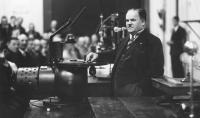The Year of Wolfke, Part 1. The precursor of television

Professor Mieczysław Wolfke delivering his lecture entitled "New elementary particles" next to an experimental apparatus, 1935, photo: National Digital Archives collection
He knew Nobel laureates, but he never received this prestigious award himself. Many people believe he deserved it. Yet, it took several years for his bold ideas to be appreciated and developed. Perhaps this is why Mieczysaw Wolfke, a scientist and inventor affiliated with Warsaw University of Technology, is still a lesser-known figure. It is time to change it.
The Polish Physical Society, the Warsaw University of Technology, the Committee of Physics of the Polish Academy of Sciences, and the Polish Photonics Society have announced that 2022 will be devoted to Wolfke. It is a tribute to an extraordinary scientist 75 years after his death and 100 years after he was appointed as a professor at Warsaw University of Technology.
The celebrations provide an opportunity to reflect on Wolfke's most significant and fascinating discoveries.
Influence of the city and his father
What can be accomplished by a boy who is in love with technology? Great things! Wolfke was 17 years old when he developed a device that was the prototype of the television - a wireless telectroscope. It enabled the transmission of images over a distance using electromagnetic waves.
– “The end of the nineteenth century marked a time of highly rapid technological growth of cities and the industries that existed within them” – says Krzysztof Petelczyc, PhD, from the Faculty of Physics of the Warsaw University of Technology, a co-author of the Mieczysław Wolfke's biography and coordinator of the celebration of the year dedicated to this scientist. – “Wolfke spent those years in Częstochowa. It was one of the first cities in Poland where electricity reached not only factories but also illuminated the symbolic Avenue of the Virgin Mary, leading to the Jasna Góra Monastery. Mieczysław's father, Karol Wolfke, worked as one of the city engineers. As a result, he frequently read references in the newspaper about technical and scientific breakthroughs, and he also brought news from nearby factories home. During this time, the Warsaw-Vienna railway line was also equipped with telegraph cables.”
Teenager's idea
This atmosphere inspired a young, gifted boy to dream and try to make his dreams come true. In his idea, Wolfke could be inspired by the achievements of Szczepanik, who presented his invention of the telectroscope for the first time in Vienna in 1896. Using special moveable mirrors and a photosensitive plate, this device converted individual points of the image into a series of electrical pulses, which were then transmitted to the receiving device and reintegrated into an image.
– “Wolfke's patent, filed in 1898 under the name ‘wireless telectroscope,’ is more similar to the achievements of Paul Nipkow, born in Lębork, who at the time patented a special shield with spirally arranged holes, which was also used to decompose the image into the brightness of its individual points in the form of a time series” – explains Petelczyc, PhD – “Wolfke employed a modified Nipkow shield and added the capability of signal transmission via electromagnetic waves to his design.”
Invention without implementation
The achievement of a seventeen-year-old boy from Częstochowa and the patent granted to him in Russia did not go unnoticed in the press at that time. But why was the invention of television implemented in the United States, and only in 1924?
– “I think the idea of transmitting images through the air appeared too futuristic at a time when electricity itself was new to society and physical theories were founded on the concept of ether” – says Petelczyc, PhD – “Neither Szczepanik, nor Wolfke, who was still young at the time, managed to implement this idea into real production. Only John Baird's technological work resulted in the first television broadcasts from London to New York in the second decade of the twentieth century (even in color). Enormous financial resources were needed to build a universally accessible television system. They were present, for example, in Germany, where the propagandist potential was recognized in television.”
It is worth noting that these TV prototypes from the 1920s and 1930s were substantially based on the technique of using transmitting and receiving antennas, as in Wolfke's patent.
More information about the Wolfke Year on the wolfke.fizyka.pw.edu.pl website.







